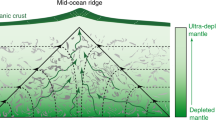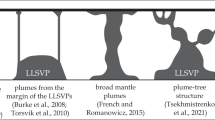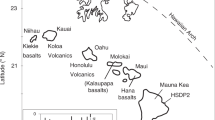Abstract
The thermal and chemical state of the early Archaean deep mantle is poorly resolved due to the rare occurrences of early Archaean magnesium-rich volcanic rocks. In particular, it is not clear whether compositional heterogeneity existed in the early Archaean deep mantle and, if it did, how deep mantle heterogeneity formed. Here we present a geochronological and geochemical study on a Palaeoarchaean ultramafic–mafic suite (3.45-Gyr-old) with mantle plume signatures in Longwan, Eastern Hebei, the North China Craton. This suite consists of metamorphosed cumulates and basalts. The meta-basalts are iron rich and show the geochemical characteristics of present-day oceanic island basalt and unusually high mantle potential temperatures (1,675 °C), which suggests a deep mantle source enriched in iron and incompatible elements. The Longwan ultramafic–mafic suite is best interpreted as the remnants of a 3.45-Gyr-old enriched mantle plume. The first emergence of mantle-plume-related rocks on the Earth 3.5–3.45 billion years ago indicates that a global mantle plume event occurred with the onset of large-scale deep mantle convection in the Palaeoarchaean. Various deep mantle sources of these Palaeoarchaean mantle-plume-related rocks imply that significant compositional heterogeneity was present in the Palaeoarchaean deep mantle, most probably introduced by recycled crustal material.
This is a preview of subscription content, access via your institution
Access options
Access Nature and 54 other Nature Portfolio journals
Get Nature+, our best-value online-access subscription
$29.99 / 30 days
cancel any time
Subscribe to this journal
Receive 12 print issues and online access
$259.00 per year
only $21.58 per issue
Buy this article
- Purchase on Springer Link
- Instant access to full article PDF
Prices may be subject to local taxes which are calculated during checkout





Similar content being viewed by others
Data availability
The authors declare that all data supporting the findings of this study are available within the article and its Supplementary Information files.
References
Arndt N. T., Lesher C. M., Barnes S. J. Komatiite (Cambridge Univ. Press, 2008).
Barnes S. J., Arndt N. T. in Earth’s Oldest Rocks 2nd edn (eds Van Kranendonk M. J., Bennett V. C. & Hoffmann J. E.) 103–132 (Elsevier, 2019).
Sossi, P. A. et al. Petrogenesis and geochemistry of Archean komatiites. J. Petrol. 57, 147–184 (2016).
Campbell, I. & Griffiths, R. The changing nature of mantle hotspots through time: implications for the chemical evolution of the mantle. J. Geol. 100, 497–523 (1992).
Herzberg, C., Condie, K. & Korenaga, J. Thermal history of the Earth and its petrological expression. Earth Planet. Sci. Lett. 292, 79–88 (2010).
Nisbet, E. G., Cheadle, M. J., Arndt, N. T. & Bickle, M. J. Constraining the potential temperature of the Archaean mantle: a review of the evidence from komatiites. Lithos 30, 291–307 (1993).
Collerson, K. D., Campbell, L. M., Weaver, B. L. & Palacz, Z. A. Evidence for extreme mantle fractionation in early Archaean ultramafic rocks from northern Labrador. Nature 349, 209–214 (1991).
Polat, A., Hofmann, A. W. & Rosing, M. T. Boninite-like volcanic rocks in the 3.7–3.8 Ga Isua greenstone belt, West Greenland: geochemical evidence for intra-oceanic subduction zone processes in the early Earth. Chem. Geol. 184, 231–254 (2002).
Friend, C. R. L. & Nutman, A. P. Dunites from Isua, Greenland: a ca. 3720 Ma window into subcrustal metasomatism of depleted mantle. Geology 39, 663–666 (2011).
Liu, D. Y., Nutman, A. P., Compston, W., Wu, J. S. & Shen, Q. H. Remnants of ≥3800 Ma crust in the Chinese part of the Sino-Korean craton. Geology 20, 339–342 (1992).
Nutman, A. P. et al. Multistage late Neoarchaean crustal evolution of the North China Craton, eastern Hebei. Precambrian Res. 189, 43–65 (2011).
Zhai, M.-G., Santosh, M. & Zhang, L. Precambrian geology and tectonic evolution of the North China Craton. Gondwana Res. 20, 1–5 (2011).
Wang, C., Song, S., Niu, Y., Wei, C. & Su, L. TTG and potassic granitoids in the eastern North China Craton: making Neoarchean upper continental crust during micro-continental collision and post-collisional extension. J. Petrol. 57, 1775–1810 (2016).
Corfu, F., Hanchar, J. M., Hoskin, P. W. & Kinny, P. Atlas of zircon textures. Rev. Mineral. Geochem. 53, 469–500 (2003).
Kirkland, C. L., Smithies, R. H., Taylor, R. J. M., Evans, N. & McDonald, B. Zircon Th/U ratios in magmatic environs. Lithos 212-215, 397–414 (2015).
Müntener, O., Kelemen, P. B. & Grove, T. L. The role of H2O during crystallization of primitive arc magmas under uppermost mantle conditions and genesis of igneous pyroxenites: an experimental study. Contributions to Mineralogy and Petrology 141, 643–658 (2001).
Lee, C.-T. A., Cheng, X. & Horodyskyj, U. The development and refinement of continental arcs by primary basaltic magmatism, garnet pyroxenite accumulation, basaltic recharge and delamination: insights from the Sierra Nevada, California. Contrib. Mineral. Petrol. 151, 222–242 (2006).
Corgne, A. et al. Trace element partitioning between majoritic garnet and silicate melt at 10–17 GPa: implications for deep mantle processes. Lithos 148, 128–141 (2012).
Herzberg, C. & Asimow, P. D. Petrology of some oceanic island basalts: PRIMELT2.XLS software for primary magma calculation. Geochem. Geophys. Geosyst. 9, Q09001 (2008).
Lee, C.-T. A., Luffi, P., Plank, T., Dalton, H. & Leeman, W. P. Constraints on the depths and temperatures of basaltic magma generation on Earth and other terrestrial planets using new thermobarometers for mafic magmas. Earth Planet. Sci. Lett. 279, 20–33 (2009).
Kushiro, I. in Earth Processes: Reading the Isotopic Code Vol. 95 (eds Basu, A. & Hart, S.) 109–122 (Wiley, 1996).
Campbell, I. H., Griffiths, R. W. & Hill, R. I. Melting in an Archaean mantle plume: heads it’s basalts, tails it’s komatiites. Nature 339, 697–699 (1989).
Campbell, I. H. & Griffiths, R. W. Implications of mantle plume structure for the evolution of flood basalts. Earth Planet. Sci. Lett. 99, 79–93 (1990).
Gibson, S. A. Major element heterogeneity in Archean to Recent mantle plume starting-heads. Earth Planet. Sci. Lett. 195, 59–74 (2002).
Jennings, E. S., Holland, T. J. B., Shorttle, O., Maclennan, J. & Gibson, S. A. The composition of melts from a heterogeneous mantle and the origin of ferropicrite: application of a thermodynamic model. J. Petrol. 57, 2289–2310 (2016).
Coffin, M. F. & Eldholm, O. Large igneous provinces: crustal structure, dimensions, and external consequences. Rev. Geophys. 32, 1–36 (1994).
Saunders, A. D. Large igneous provinces: origin and environmental consequences. Elements 1, 259–263 (2005).
Ernst, R. E. & Jowitt, S. M. in Tectonics, Metallogeny, and Discovery: the North American Cordillera and Similar Accretionary Settings (eds Colpron, M., Bissig, T. et al.) 17–51 (Society of Economic Geologists, 2013).
Ernst, R. & Bleeker, W. Large igneous provinces (LIPs), giant dyke swarms, and mantle plumes: significance for breakup events within Canada and adjacent regions from 2.5 Ga to the Present. Can. J. Earth Sci. 47, 695–739 (2010).
Barley, M. E., Krapez, B., Groves, D. I. & Kerrich, R. The Late Archaean bonanza: metallogenic and environmental consequences of the interaction between mantle plumes, lithospheric tectonics and global cyclicity. Precambrian Res. 91, 65–90 (1998).
Gibson, S. A., Thompson, R. N. & Dickin, A. P. Ferropicrites: geochemical evidence for Fe-rich streaks in upwelling mantle plumes. Earth Planet. Sci. Lett. 174, 355–374 (2000).
Milidragovic, D. & Francis, D. Ca. 2.7 Ga ferropicritic magmatism: a record of Fe-rich heterogeneities during Neoarchean global mantle melting. Geochim. Cosmochim. Acta 185, 44–63 (2016).
Zhang, J., Liu, Y., Ling, W. & Gao, S. Pressure-dependent compatibility of iron in garnet: insights into the origin of ferropicritic melt. Geochim. Cosmochim. Acta 197, 356–377 (2017).
Hanski, E. J. & Smolkin, V. F. Iron- and LREE-enriched mantle source for early Proterozoic intraplate magmatism as exemplified by the Pechenga ferropicrites, Kola Peninsula, Russia. Lithos 34, 107–125 (1995).
Stone, W. E., Crocket, J. H., Dickin, A. P. & Fleet, M. E. Origin of Archean ferropicrites: geochemical constraints from the Boston Creek Flow, Abitibi greenstone belt, Ontario, Canada. Chem. Geol. 121, 51–71 (1995).
Francis, D., Ludden, J., Johnstone, R. & Davis, W. Picrite evidence for more Fe in Archean mantle reservoirs. Earth Planet. Sci. Lett. 167, 197–213 (1999).
Goldstein, S. B. & Francis, D. The petrogenesis and mantle source of Archaean ferropicrites from the Western Superior Province, Ontario, Canada. J. Petrol. 49, 1729–1753 (2008).
Valley, J. W. Oxygen isotopes in zircon. Rev. Mineral. Geochem. 53, 343–385 (2003).
Winchester, J. A. & Floyd, P. A. Geochemical discrimination of different magma series and their differentiation products using immobile elements. Chem. Geol. 20, 325–343 (1977).
Sun, S. S. & McDonough, W. F. in M agmatism in the Ocean Basins (eds Saunders, A. D. & Norry, M. J.) 313–345 (Geological Society, 1989).
Arndt, N. Komatiites, kimberlites, and boninites. J. Geophys. Res. Solid Earth 108(B6), 2293 (2003).
Katz, R. F., Spiegelman, M. & Langmuir, C. H. A new parameterization of hydrous mantle melting. Geochem. Geophys. Geosyst. 4, 1073 (2003).
Li, X.-H., Liu, Y., Li, Q.-L., Guo, C.-H. & Chamberlain, K. R. Precise determination of Phanerozoic zircon Pb/Pb age by multicollector SIMS without external standardization. Geochem. Geophys. Geosyst. 10, Q04010 (2009).
Sláma, J. et al. Plešovice zircon—a new natural reference material for U–Pb and Hf isotopic microanalysis. Chem. Geol. 249, 1–35 (2008).
Wiedenbeck, M. et al. Three natural zircon standards for U–Th–Pb, Lu–Hf, trace element and REE analyses. Geostandard. Newslett. 19, 1–23 (1995).
Li, X.-H. et al. Qinghu zircon: a working reference for microbeam analysis of U–Pb age and Hf and O isotopes. Chinese Sc. Bull. 58, 4647–4654 (2013).
Stacey, J. S. & Kramers, J. Approximation of terrestrial lead isotope evolution by a two-stage model. Earth Planet. Sci. Lett. 26, 207–221 (1975).
Ludwig K. R. User’s Manual for Isoplot 3.0: A geochronological toolkit for Microsoft Excel (Berkeley Geochronology Centre, 2003).
Li, X.-H. et al. Petrogenesis and tectonic significance of the ∼850 Ma Gangbian alkaline complex in South China: evidence from in situ zircon U–Pb dating, Hf–O isotopes and whole-rock geochemistry. Lithos 114, 1–15 (2010).
Wiedenbeck, M. et al. Further characterisation of the 91500 zircon crystal. Geostandard. Geoanal. Res. 28, 9–39 (2004).
Wu, F.-Y., Yang, Y.-H., Xie, L.-W., Yang, J.-H. & Xu, P. Hf isotopic compositions of the standard zircons and baddeleyites used in U–Pb geochronology. Chem. Geol. 234, 105–126 (2006).
Morel, M. L. A., Nebel, O., Nebel-Jacobsen, Y. J., Miller, J. S. & Vroon, P. Z. Hafnium isotope characterization of the GJ-1 zircon reference material by solution and laser-ablation MC-ICPMS. Chem. Geol. 255, 231–235 (2008).
Pearce, N. J. G. et al. A compilation of new and published major and trace element data for NIST SRM 610 and NIST SRM 612 glass reference materials. Geostandard. Newslett. 21, 115–144 (1997).
Song, S. G. et al. Tracing the 850-Ma continental flood basalts from a piece of subducted continental crust in the North Qaidam UHPM belt, NW China. Precambrian Res. 183, 805–816 (2010).
Weaver, S. J. & Langmuir, C. H. Calculation of phase equilibrium in mineral-melt systems. Comput. Geosci. 16, 1–19 (1990).
Niu, Y. Mantle melting and melt extraction processes beneath ocean ridges: evidence from abyssal peridotites. J. Petrol. 38, 1047–1074 (1997).
Niu Y., Gilmore T., Mackie S., Greig A., Bach W. Mineral chemistry, whole-rock compositions, and petrogenesis of Leg 176 gabbros: data and discussion. In Proc. Ocean Drilling Program, Scientific Results Vol. 176 (eds Natland, J. H., Dick H. J. B. et al.) 1–60 (Ocean Drilling Program, 2002).
Roeder, P. L. & Emslie, R. F. Olivine–liquid equilibrium. Contrib. Mineral. Petrol. 29, 275–289 (1970).
Putirka, K. D. Thermometers and barometers for volcanic systems. Rev. Mineral. Geochem. 69, 61–120 (2008).
Barnes, S. J. The effect of trapped liquid crystallization on cumulus mineral compositions in layered intrusions. Contrib. Mineral. Petrol. 93, 524–531 (1986).
Acknowledgements
We thank S. Gibson for constructive discussions. This study was supported by the National Natural Science Foundation of China (grant nos 41430207, 41572040 and 41372060) and the Fundamental Research Funds for the Central Universities of China (grant no. 2652018115). C.Wang acknowledges the Chinese Scholarship Council for financial support during his visit to Durham University (grant no. 201606010063).
Author information
Authors and Affiliations
Contributions
C.Wang and S.S. designed the project and wrote the manuscript. C.Wang, S.S., C.Wei and J.D. conducted fieldwork. C.Wang, L.S. and X.-H.L. performed all the analyses. All the authors contributed to the interpretation of the results and the revision of the manuscript.
Corresponding authors
Ethics declarations
Competing interests
The authors declare no competing interests.
Additional information
Publisher’s note: Springer Nature remains neutral with regard to jurisdictional claims in published maps and institutional affiliations.
Supplementary information
Supplementary information
Supplementary Figs. 1–10 and Tables 1–6
Rights and permissions
About this article
Cite this article
Wang, C., Song, S., Wei, C. et al. Palaeoarchaean deep mantle heterogeneity recorded by enriched plume remnants. Nat. Geosci. 12, 672–678 (2019). https://doi.org/10.1038/s41561-019-0410-y
Received:
Accepted:
Published:
Issue Date:
DOI: https://doi.org/10.1038/s41561-019-0410-y
This article is cited by
-
Light oxygen isotopic composition in deep mantle reveals oceanic crust subduction before 3.3 billion years ago
Communications Earth & Environment (2024)
-
Mineral chemistry, geochemistry and geophysical investigations of Simlipal volcanics from Eoarchean Singhbhum Craton (Eastern India): geodynamic implications of pervasive plume–lithosphere interaction
International Journal of Earth Sciences (2022)



